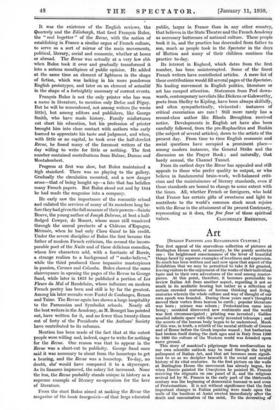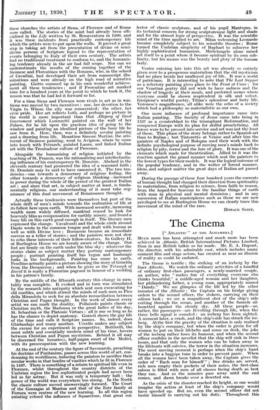Art
[ITALIAN PAINTING AND RENAISSANCE CULTURE.]
Tim first appeal of the marvellous collection of pictures at Burlington House must, of necessity, be the purely aesthetic one : the heightened consciousness of the lover of beautiful things faced by supreme examples of loveliness and expression. So much has been written and said now upon that aspect of the Exhibition that we may be permitted to take it for granted, leavingvisitors to the enjoyment of the works of theirindividual taste and to their own adventures of the soul among master- pieces. At this point, therefore, it becomes permissible to review Italian Art from another aspect, regarding it not so much in its aesthetic bearing but rather as a reflection of certain crowded centuries of human thinking and living, centuries wherein the whole culture and way of thought of our own epoch was founded. During those years men's thoughts moved their vortex from heaven to earth ; popular literature was born ' • science was reborn ; Protestantism came into being • mankind discovered new continents and the world was first circumnavigated ' • printing was invented ; Galileo assailed infinite space with the newly invented telescope ; and the secrets of the human body began to be understood. Much of this was, in truth, a rebirth of the mental attitude of Greece and of Rome before the Greek impulse waned' but barbarism had broken itself during the dark ages and in Italy from 1200 to 1600 the culture of the Western world was founded upon surer ground.
This story of mankind's pilgrimage from mediaevalism to our own scientific outlook may be read through the bright palimpsest of Italian Art, and that art becomes more signifi- cant to us as we decipher beneath it the social and mental history of its vital centuries. In the first picture on the walls at. Burlington House the movement has already begun, for when Duccio painted the Crucifixion he painted St. Francis receiving the stigmata on one panel of it, and the religious revival led by St. Francis in the early part of the thirteenth century was the beginning of democratic humanism and even of Protestantism. It is not without significance that the first important changes in Italian painting were made upon the walls of the basilicas at Assisi erected immediately after the death and canonization of the saint, To the decorating of these churches the artists of Siena, of Florence and of Rome were called. The stories of the saint had already been offi. cialized in the Life written by St. Bonaventura in 1260, and it was these incidents from practically contemporary life which the artists were to put upon the walls. It proved a great step in taking art from the presentation of divine or semi- divine persons of Scripture legend to the representation of events belonging to Italy of their own century. The artists had no traditional treatment to conform to, and the humaniz- ing tendency already in the air had full scope. Nor can we underestimate the results of the coming together of the Siennese and Florentines with the Romans, who, in the school of Cavallini, had developed their art from manuscript illu- minations and were .already on the high road of narrative painting. Giotto summed up in his own wonderful achieve- ment all these tendencies ; and if Frorentine art marked time for a hundred years at the point to which he took it, the reason was that he had led it forward so far.
For a time Siena and Florence were rivals in art as in war. Siena was moved by two incentives : one, her devotion to the Virgin to Whom the city was consecrated ; the other, her civic pride. Her art reflects both, and perhaps no picture in the world is more important than that Allegory of Good Government which Lorenzetti painted on the wall of her Palace, for he hit upon the gracious idea of going to the window and painting an idealized picture of the busy life he saw from it. Here, then, was a definitely secular painting and a drawing from life. Meantime Simone Martini, the aris- tocrat of Siennese painting, went to Avignon, where he came into touch with Petrarch, painted Laura, and linked Italian art with the Troubadour culture of Provence.
Alongside the humanizing of religion initiated by the teaching of St. Francis, was the rationalizing and intellectualiz- ing influence of his contemporary St. Dominic. Abelard in the eleventh century had pioneered the idea of a reasoned faith ; St. Dominic may be said to have canonized it. The two ten- dencies—one towards a democracy of religious feeling, the other towards a democracy of religious thinking—increased in power during the whole of the period of the greatest Italian art ; and since that art, in subject matter at least, is funda- mentally religious, our understanding of it must take cog- nizance of this dual movement of Renaissance thought.
Actually these tendencies were themselves but part of the whole drift of men's minds towards the realization of life at its fullest here upon earth. With increased security, increasing wealth more widely diffused, mankind ceased to look for heavenly bliss as compensation for earthly misery, and found a busy life on this earth good enough in itself. The literary men expressed the change. Cavalcanti and the whole circle around Dante wrote in the common tongue and dealt with human as well as with Divine love ; Boccaccio became an immediate success as a teller of stories ; and the painters were not slow to echo these interests of their fellow-creators. In Gallery II. at Burlington House we are keenly aware of the change. Our feet are firmly on the earth under the blue sky ; whatever the stories claim as subject matter they portray contemporary people ; portrait painting itself has begun and landscape lurks in the backgrounds. Painting has come to earth. Pesellino actually paints a picture showing the story of Griselda from the Deeameron ; and when he gives us the Triumph of David it is really a Florentine pageant in honour of a wedding in his patron's family.
By the middle of the fifteenth century this change in men- tality was complete. It evoked and in turn was stimulated by the research into antiquity which sent men excavating for old marbles, and which stirred the minds of such men as Pico della Mirandola to seek for an absolute reconciliation between Christian and Pagan thought. In the work of almost every artist we can mark the duality. Pollaiuolo paints classic or Christian myth, the Madonna or the great ladies of his day, St. Sebastian or the Platonic Virtues : all is one so long as he has the chance to depict anatomy. Gozzoli shows the gay life of the time and calls it Scripture names. So, indeed, does Ghirlandajo and many another. Uccello makes any subject the excuse for an experiment in perspective. Botticelli, the most subtle and essentially modern mind of his time, hovers between Christian and Pagan mysticism. Behind it all may be discerned the luxurious, half-pagan court of the Medici, with its preoccupation with the new learning.
At the end of the century the figure of Savonarola, preaching his doctrine of Puritanism, passes across this world of art, con- demning its worldliness, inducing the painters to sacrifice their secular works in that bonfire of vanities which he lit in Florence in 1497. There is something of a return to spiritual life even in Florence, whilst throughout the country districts of the Umbrian region the less sophisticated people had never been led so far astray. But it was only 'a temporary halt ; the power of the world was everywhere too strong. ' In the North the classic culture moved unswervingly forward. The Court of the Gonzagas at Mantua and that of the Este family at Ferrara were centres of the new learning. In all this region painting echoed the influence of Squarcione, that great col-
lector of classic sculpture, and of his pupil Mantegna, in its technical concern for strong sculpturesque light and shade and for the utmost logic of perspective. It was the scientific mind of the time applied to art. Milan welcoming Leonardo became completely subject to his scientific theories • Rome turned the Umbrian simplicity of Raphael to subserve her highly sophisticated humanism. Michelangelo alone raised art itself to a point where it became spiritual by its own sub- limity, but his means was the beauty and glory of the human body.
Venice entering late into this art was already so entirely given over to a prosperous materialism that the old mysticism had no place beside her unalloyed joy of life. It was a world of patricians. It is interesting to note that The Last Supper as a refectory painting gives place to the Feast at Cana ; for our Venetian gentry did not wish to have sadness and the shadow of tragedy at their meals, and preferred scenes where everyone could be shown resplendent in silk and velvet. Giorgione's wistful poetry, Titian's splendour and lusty life, Veronese's magnificence, all alike were the echo of a society which had a philosophy as materialistic as our own.
One more influence of profound importance came into Italian painting. The Society of Jesus came into being in 1537 as a counterblast to the triumphant Reformation, and conquered Europe with its plan for skilful proselytizing. All forces were to be pressed into service and art was not the least of these. This phase of the story belongs rather to Spanish art than to Italian ; but Tintoretto at Venice and after him the painters of Naples and of Bologna used their work with the definite psychological purpose of moving men's minds back to religion bypity, terror and the lure of glory. It was one of the elements which made for theatricalism. Allied to it was the reaction against the grand manner which sent the painters to the lowest types for their models. It was the logical outcome of the popular tendency, and in the welter of forced manner, ideas, and subject matter the great days of Italian art passed away.
During the passage of those four hundred years the currents of human thought had changed their direction from spirituality to materialism, from religion to science, from faith to reason, from the hoped-for heavens to the familiar things of earth with man in physical and mental dominion ; and in any succession of Italian masterpieces such as those we are now privileged to see at Burlington House we can clearly trace this movement of the mind of the race.
HORACE SHIPP.







































 Previous page
Previous page